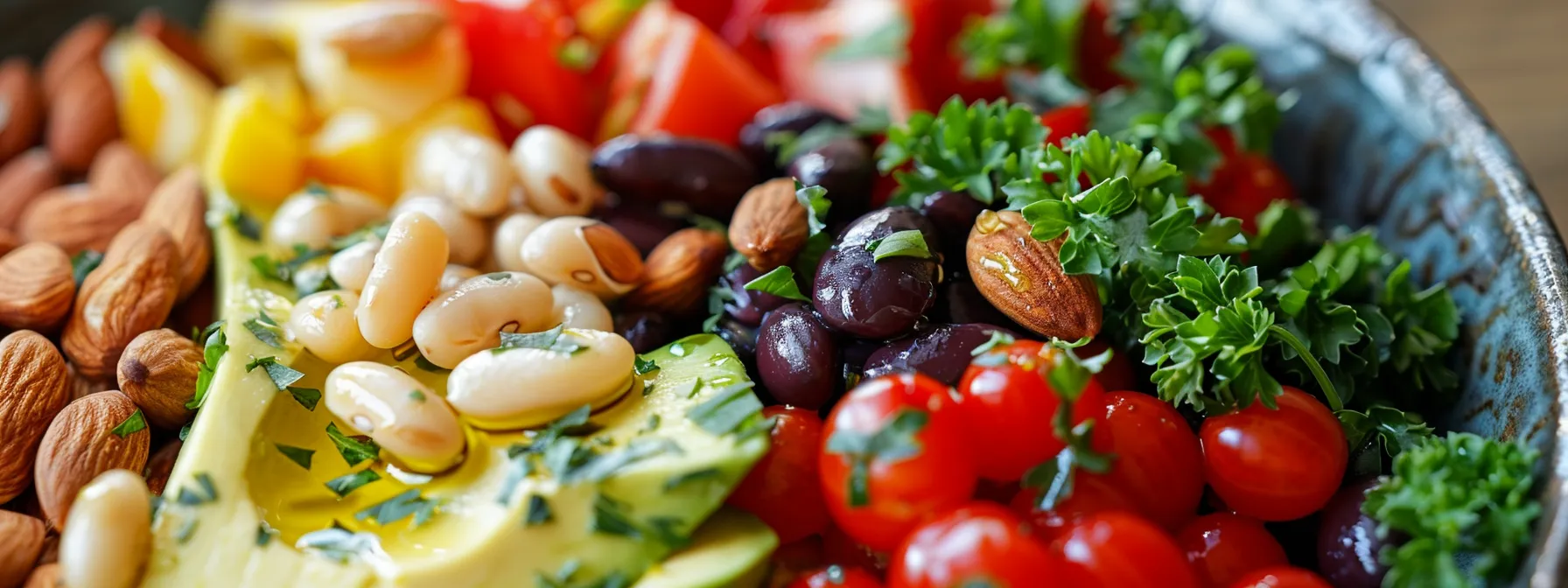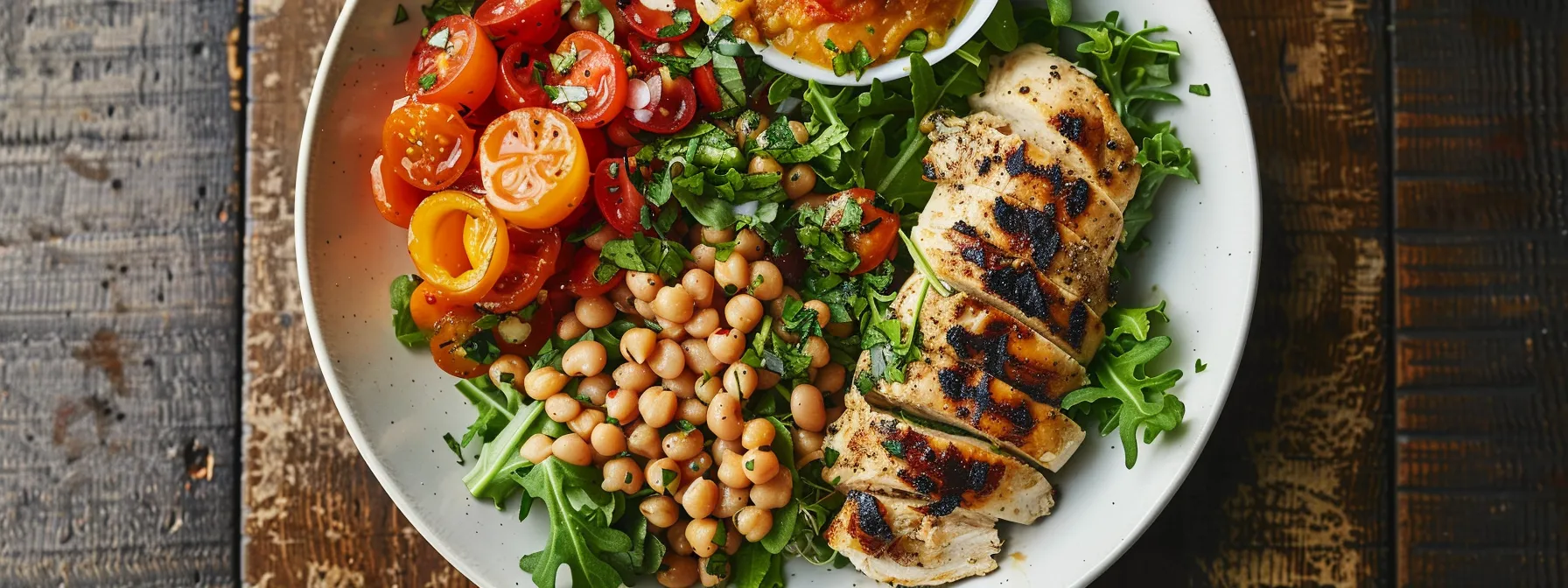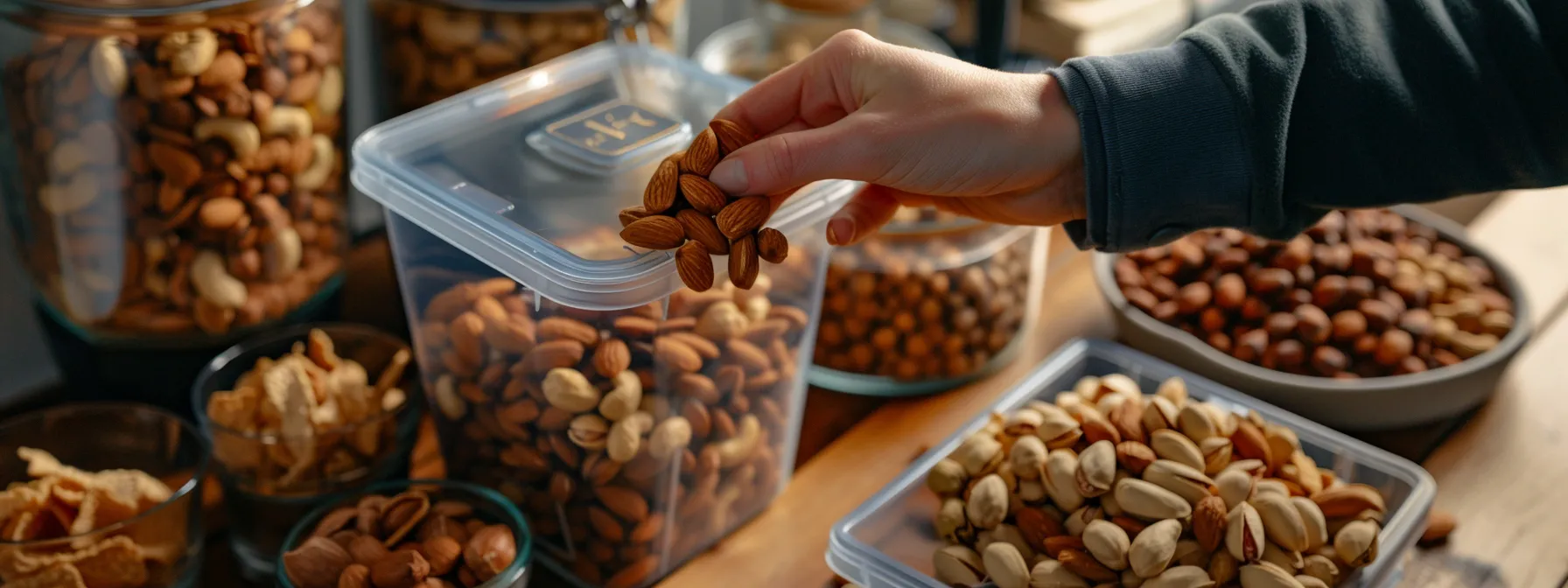Table Of Contents:
- Ectomorph Eating Plan Essentials: Foods and Strategies for Optimal Growth
- What Should Ectomorphs Eat?
- Understanding Caloric Needs for Ectomorphs
- Balancing Macronutrients for Muscle Gain
- Timing Meals for Optimal Absorption and Growth
- Recommended Foods for Ectomorphs
- Recommended Proteins to Support Muscle Repair
- Recommended Carbs for Energy and Mass Gain
- Recommended Fats for Hormonal Balance and Health
- Structuring Your Ectomorph Eating Plan
- Creating a Meal Plan for a Week
- Pre and Post-Workout Nutrition Strategies
- Supplements That Can Aid Ectomorphs
- Challenges Ectomorphs May Face in Their Diet
- Managing Fast Metabolism and High Calorie Needs
- Overcoming Plateaus in Weight and Muscle Gain
- How Hydration Affects Ectomorphs
- The Importance of Staying Hydrated for Muscle Recovery
- Best Practices for Incorporating Fluids Into Your Diet
- Snack Ideas for Ectomorphs on the Go
- High-Calorie Snacks That Support Muscle Gain
- Easy and Quick Snack Recipes for Busy Schedules
- Adjusting Your Ectomorph Diet for Long-Term Success
- When to Adjust Caloric Intake as You Grow
- Adapting the Diet to Lifestyle Changes and Age
- Conclusion
Ectomorph Eating Plan Essentials: Foods and Strategies for Optimal Growth
Embarking on a path to muscular growth and overall health as an ectomorph means paying close attention to the ingredient list of your meals. When it comes to eating, knowing what works best for your body type can transform your fitness journey. Envision filling your bowl with nutritious choices like cucumber and spinach, which not only fuel your workouts but also assist in recovery and muscle building. Structuring an effective ectomorph eating plan requires a blend of strategy and nutritional understanding. In this article, we’ll delve into the essentials of an ectomorph diet to ensure you’re well-equipped for optimal growth and wellness.
What Should Ectomorphs Eat?

As I delve into the unique dietary landscape of ectomorphs, understanding the nuances of proper nutrition becomes as foundational as a sturdy dumbbell in a balanced fitness routine. Your slender frame necessitates a tailored approach to caloric consumption, ensuring that you’re fueling your body with energy surpluses apt for growth and recovery. It’s not just about piling on more food, but choosing the right mix—think of your plate as a mosaic, with vibrant olive oils, hearty beans, nutrient-rich almonds, and creamy avocado pieces coming together to form the perfect picture of health. Balancing macronutrients is akin to a well-choreographed dance, where proteins, carbohydrates, and fats play leading roles in sculpting your physique. Moreover, the choreography extends to meal timing, a strategic endeavor that enhances nutrient absorption and catalyzes muscle growth. Let’s examine these strategies closely, aligning our eating patterns to the ultimate goal of transformation and wellbeing.
Understanding Caloric Needs for Ectomorphs
Recognizing the appropriate caloric intake is a critical step for ectomorphs aiming to increase their body fat percentage healthily. Given our fast metabolism, we must consume enough calories that not only support our basal metabolic functions but also provide the extra energy required for muscle repair and growth, ensuring that the delicate balance between energy consumption and expenditure tilts favorably towards mass gain.
Strategic inclusion of calorie-dense foods is integral; for instance, adding a dollop of cream to a smoothie or munching on mixed nuts can offer the additional caloric boost we need. These dietary choices are not merely about increasing quantity but focus on providing the body with quality macros that act as building blocks for muscle and serve as essential cosmetics for our internal environment, ultimately optimizing the storage of glycogen for sustained energy levels.
Balancing Macronutrients for Muscle Gain
My advice for fellow ectomorphs is clear: mastering the balance of macronutrients can dawn a new era in muscle gain. Carbohydrates, like those found in pasta and brown rice, play a vital role in replenishing glycogen stores within skeletal muscle, promoting recovery and growth after rigorous workouts. These starch-rich foods foster not only a behavior of sustained energy release but also support a framework conducive to hypertrophy.
| Macronutrient | Role | Examples |
|---|---|---|
| Carbohydrates | Glycogen replenishment | Pasta, Brown Rice |
| Proteins | Muscle repair and growth | Chicken breast, Eggs, Legumes |
| Fats | Energy and hormone production | Avocado, Nuts, Olive oil |
Understanding how each macro affects our body is transformative: proteins are the bricks and mortar for skeletal muscle, crucial for repair and build-up. Meanwhile, fats are not to be shunned; they are imperative, providing energy and aiding in hormone production, which in turn signals muscle growth and bolsters overall health. It’s a delicate juggling act, one that requires attentiveness and an intuitive touch with our dietary habits.
Timing Meals for Optimal Absorption and Growth
Grasping the concept of meal timing, I’ve learned, is not just about what we eat but when we eat, intricately linking our brand of fitness goals with the natural rhythms of our bodies. To optimize our basal metabolic rate and accommodate its quick pace, I aim to space out my meals and snacks throughout the day, which supports a more efficient absorption of nutrients and can positively influence body composition.
For me, breakfast is non-negotiable, with a nutrient-rich bowl of oatmeal providing a slow-releasing source of carbohydrates that aligns closely with accessibility and usage of energy as the day unfolds. Eating in harmony with my body’s needs helps boost metabolism and lends a sustained energy supply, essential for fostering an environment ripe for growth.
As an ectomorph, your unique metabolic needs call for a specific dietary approach. Let’s dive into the foods that will fuel your body right.
Recommended Foods for Ectomorphs

Grasping the proper nutritional framework is like adding weight to the barbell of your wellness routine; it’s critical for achieving your physique goals. As an ectomorph, your dietary emphasis should accentuate proteins that assist in mending and fortifying muscle fibers, particularly after a workout that puts your shoulders to the test. Acknowledging this, the pursuit of proteins becomes as targeted as any fitness regimen aiming for hypertrophy. Equally pivotal are the carbs, acting as the fuel that keeps you pushing through, whether it’s a hip thrust or a sprint, enabling both energy sustenance and mass gain. Lastly, we cannot ignore the spectrum of fats, from the omega-rich nut to the monounsaturated riches of olive oil, each serving a purpose in maintaining hormonal equilibrium and overall health, adding layers of effectiveness to our endeavors.
Recommended Proteins to Support Muscle Repair
For anyone immersed in the world of bodybuilding with an ectomorph body type, integrating a quality protein supplement can accelerate the process of muscle repair. Enhanced protein intake has a direct correlation with hormone balances that drive anabolism and repair, supporting the strengthening not just of muscle but bone as well, a critical consideration in the comprehensive approach to fitness.
My own muscle recovery regimen is strengthened through a focus on proteins that work in concert with my genes, fostering effective muscle repair mechanisms. These foods, rich in essential amino acids, support the framework of my cells, helping to expedite tissue rebuilding after the intense demands of weight training and cardio exercises.
Recommended Carbs for Energy and Mass Gain
When considering carbs for energy and mass gain, I always include fruits like watermelon and pineapple in my diet. These not only quench my thirst but provide a rapid infusion of energy, which is crucial for my workouts. They come with the added benefit of hydration, often overlooked during intense training sessions.
The art of baking also steps into the spotlight in my nutrition plan, offering a variety of carbohydrate-rich options. But here’s where I face a risk: the need to choose complex carbs over simple sugars to ensure the fuel is sustained and beneficial. By opting for whole-grain breads and starchy vegetables, this threat is mitigated, aligning with my goals for continuous energy and effective mass gain.
| Carbohydrate Source | Type | Role in Energy and Mass Gain |
|---|---|---|
| Watermelon | Fruit – Simple Sugar | Quick energy source, Hydration |
| Pineapple | Fruit – Simple Sugar | Energy boost, Digestive health |
| Whole-Grain Breads | Grain – Complex Carb | Sustained energy release, Muscle fuel |
Recommended Fats for Hormonal Balance and Health
In my journey to achieve hormonal balance and build a healthy body, I’ve discovered fats play a crucial role. Incorporating sources of good fats into my meal plan, like those found in fish and flax seeds, not only supports my skin‘s health but also aids in the intricate dance of hormone production.
To ensure my snacks are contributing to my wellness goals, I’ve become particular about including fats from various sources. Snack choices like a slice of whole-grain bread with almond butter or a few slices of avocado with my meals are not just satisfying but fuel my body efficiently and bolster hormonal health, key for an animal of routine like myself.
- Incorporate good fats to support skin health and hormone production
- Select snacks and meal components with beneficial fats
- Choose whole-grain bread and avocado for satisfying, health-boosting options
Now that we’ve highlighted the best foods to fuel your ectomorph physique, it’s time to create a structured eating plan that stays in sync with your body’s needs. Let’s dive into organizing these nutritional powerhouses into a daily diet that’s as effective as it is satisfying.
Structuring Your Ectomorph Eating Plan

When I chart a path forward for my ectomorph eating plan, I consult with my physician to tailor a program that caters to my body’s idiosyncrasies, steering clear of a one-size-fits-all approach. Planning meals for an entire week ensures that I integrate nutrient-rich vegetables like broccoli, balancing my diet beyond the pursuit of muscle gain, to encompass overall health and forestall unwanted weight loss. With every gram of protein carefully accounted for, I’m meticulous about the delicate calibration of my diet. Now, let’s move into the meticulous crafting of a weekly meal plan, the smart strategies surrounding pre and post-workout nourishment, and identify supplements that complement my routine, all orchestrated to magnify the growth potential of an ectomorph physique like mine.
Creating a Meal Plan for a Week
With foresight and strategy, I design a week’s worth of meals tailored for the high metabolic needs of an ectomorph body type, as characterized by the somatotype theory of William Herbert Sheldon. This plan includes diverse protein sources like chicken, fish, and legumes, ensuring I’m not over-relying on classic favorites like peanut butter, which, although protein-rich, is also high in fats.
In aligning my diet with my fitness ambitions, it is crucial to consider each meal comprehensively, where proteins work to repair muscle fibers, and carbs serve as the main energy reservoir for my often overstretched stomach. Carefully crafted dinners end with a plate that hosts vibrant greens such as asparagus alongside grains and seeds, aimed at comprehensive nutrition:
- Pair roasted chicken with quinoa and a side of steamed asparagus.
- Mix brown rice with black beans and sprinkle with pumpkin seeds for a midday meal.
- For breakfast, opt for oatmeal topped with chia seeds and a generous dollop of peanut butter.
Pre and Post-Workout Nutrition Strategies
My approach to pre-workout nutrition embraces the practice of eating a balanced meal a few hours prior to exercise, resisting the tendency for fasting that may become trendy but doesn’t cater to my body’s need for a steady supply of energy. Including a portion of seafood, rich in protein and essential nutrients, primes my muscles for the exertion ahead and ensures that I’m well-hydrated with plenty of water, staving off any performance-diminishing dehydration.
The post-workout window is a time when my body screams for replenishment, and I’ve found that incorporating a mix of protein and healthy fats accelerates recovery. A meal that includes salmon, not only a premium source of omega-3 fatty acids but also an excellent muscle repair agent, alongside a serving of cottage cheese—a slow-releasing protein—supports my muscles through the recovery phase and leads to more effective gains.
| Timings | Nutrients | Food Examples |
|---|---|---|
| Pre-Workout | Protein, Hydration | Seafood, Water |
| Post-Workout | Protein, Healthy Fats | Salmon, Cottage Cheese |
Supplements That Can Aid Ectomorphs
Integrating supplements into my eating plan isn’t an escape from a well-founded diet, but rather a smart tactic to elevate my intake. In line with this, coconut oil has emerged as a protagonist in my supplement arsenal, not just for its medium-chain triglycerides known for energy, but also for the food density it contributes, a critical component for someone with my somatotype. It seamlessly enhances the caloric profile of oats or a smoothie, in alignment with the science advocating for heightened caloric consumption for ectomorphs.
Turning to the foundation of muscle building, protein supplements stand out. My preference leans towards those with fewer fillers, and a whey protein that I can mix with ingredients like ground beef in a meal, ensuring I’m meeting my protein requirements without compromising on my pursuit of quality foods and balanced density in every dish. This deliberate supplementation is a nod to the robust findings in nutrition science that underscore the necessity of adequate protein for muscular hypertrophy, especially in ectomorphs.
Crafting your ectomorph eating plan is just the beginning. Let’s tackle the possible hurdles head-on and ensure your nutritional journey is as smooth as it is effective.
Challenges Ectomorphs May Face in Their Diet

Navigating the dietary needs as an ectomorph presents a distinctive set of hurdles, central among them is wrangling the ever-ravenous beast that is a fast metabolism. This innate physiological trait inflates our caloric demands, requiring a carefully calibrated ratio of nutrients to keep the fires stoked without careening into excess. My meal plan has to acknowledge the velocity at which my body burns energy, much like kindling to a flame. On the other side of the spectrum lies the challenge of stagnation—those vexing plateaus in weight and muscle gain that every ectomorph inevitably encounters. Despite a diet that might feature leafy greens, blood-nourishing beets, and a vibrant array of produce like tomatoes and mangos, my own gains can become elusive, as ephemeral and stubborn as developing calf muscles. The quest for equilibrium in the ectomorph diet is a delicate one, always toeing the line between fueling growth and maintaining health.
Managing Fast Metabolism and High Calorie Needs
As an ectomorph with a rapid metabolism, the concern isn’t merely weight gain; it’s about sustainable, healthy growth. My approach includes strategic snacking on high-calorie foods with a focus on whole nutrition—like grabbing a pear when the midday hunger strikes to provide natural sugars and fiber, perfectly aligning with my physical fitness goals while ensuring I’m not simply filling up on empty calories.
Elevating my daily calorie count isn’t just about eating more; it’s about making smarter, denser food choices. To this end, a protein bar has become my trusty companion, offering a compact source of essential nutrients that staves off muscle breakdown and promotes growth. Moreover, these bars are conveniently portable, helping me avoid vending machine temptations that could detract from not only my physique but also my overall resistance to disease.
Overcoming Plateaus in Weight and Muscle Gain
Reaching a plateau in my journey towards weight and muscle gain can often feel like hitting an invisible wall, a frustrating barrier that leads many ectomorphs to question their strategy. Innovation in my routine is crucial, introducing diversity in both exercise and nutrition to stimulate growth; I find that incorporating joint-friendly yoga sessions can enhance flexibility and aid muscle recovery, complementing my regular strength training regimens.
- Incorporate joint-friendly yoga for enhanced flexibility and muscle recovery.
- Introduce nutritional diversity with foods like onion that offer unique health benefits.
- Review and adjust carbohydrate intake to ensure it’s in line with current fitness levels.
Aside from adapting my fitness routine, I pay close attention to my diet, considering the inclusion of new elements that bring both flavor and function. A simple ingredient like the onion, with its layers of nutritional benefits, becomes part of my culinary arsenal. Paired with a carbohydrate-rich meal, such adaptation can serve as both preventive medicine and a catalyst for renewed muscle growth.
Navigating dietary choices is only part of the puzzle. Let’s turn our attention to the impact of hydration on the ectomorph body type.
How Hydration Affects Ectomorphs

Among the lesser-discussed but equally important factors in an ectomorph’s nutritional strategy is the role of hydration. Staying hydrated doesn’t just quench thirst; it’s vital for muscle recovery and overall bodily function. While I’m mindful about incorporating protein-rich foods like poultry, and watching my intake of things like cholesterol for heart health, and monitoring blood pressure through diet, I’ve realized that these efforts are complementary to adequate fluid intake. Beverages such as water infused with a hint of chocolate for flavor or electrolyte-packed drinks can seamlessly integrate into my daily routine, reinforcing my muscles’ repair process and ensuring my cells operate at their best. In the next passages, I’ll dissect the significances of hydration and share actionable guidelines on how to weave fluids effectively into your diet, ensuring every element of wellness is addressed.
The Importance of Staying Hydrated for Muscle Recovery
Ensuring my muscles recover post-workout is tantamount to prepping them for the next session. Sufficient hydration not only replenishes what’s lost through sweat but also maintains the muscle‘s ability to heal and grow; it’s like adding a generous tablespoon of water to oatmeal, creating the perfect consistency, rather than a dry, unpalatable mixture.
Sipping on water throughout the day becomes as crucial to my fitness regimen as selecting the right weights for a workout. Ignoring hydration can lead to muscle stiffness, much as neglecting a toast in the toaster can result in an undesired char. Plus, staying hydrated supports blood pressure regulation, which is vital for those managing hypertension, and can improve the taste and texture of foods like a chewy raisin, making each bite more enjoyable.
| Aspect of Hydration | Benefits for Muscle Recovery | Daily Practices |
|---|---|---|
| Fluid Replenishment | Prevents muscle stiffness and facilitates repair | Drinking water consistently, especially post-exercise |
| Blood Pressure Regulation | Supports cardiovascular health, beneficial for those with hypertension | Monitoring fluid intake, avoiding excessive caffeine |
| Enhanced Food Experience | Improves taste and consistency of foods, making nutritious choices more appealing | Including hydrating foods in meals, like fruits with high water content |
Best Practices for Incorporating Fluids Into Your Diet
Amidst the ebb and flow of a daily routine, incorporating fluids that carry additional nutrients becomes a hidden gem in my ectomorph diet. For instance, swapping a midday cookie with Greek yogurt can be beneficial; this change not only brings about a creamier delight but infuses my body with essential fluids and probiotics that support digestive health, crucial after heavy exercises or a lengthy turkey trot.
Hydration isn’t merely about drinking water; it’s about strategically layering your fluid intake throughout the day. Enjoying beverages with meals, like a glass of water or milk alongside a turkey sandwich, seamlessly intertwines necessary hydration with nutrient intake without feeling intrusive or forced, thus complementing my disciplined pursuit of wellness and growth.
Understanding the impact of proper hydration paves the way for another vital component of ectomorph wellness: nutrition. Let’s shift our focus to snacking smart and staying energized with some creative on-the-go ideas.
Snack Ideas for Ectomorphs on the Go

Acknowledging the pivotal role of nutritional intake in weight gain and lean body mass development, I’ve learned that eating as an ectomorph extends beyond just the main meals. Smart snacking can significanly augment your strategy for weight management, serving as both a catalyst for growth and a practical way to consume the high calories needed. Whether it’s the subtle bite of garlic infused into a homemade spread or the simple pleasure of mixed nuts, choosing the right snacks becomes integral to sustaining energy and supporting muscle gain. This entails pinpointing nourishing options that not only align with a bustling schedule but also provide that necessary caloric heft an ectomorph requires. Let’s delve into the high-calorie snack selections that are not only beneficial for muscle synthesis but are also tailored to meet the demands of a busy lifestyle, ensuring sustenance can be both expedient and delicious.
High-Calorie Snacks That Support Muscle Gain
Strategically snacking throughout the day is a game-changer in my growth journey as an ectomorph, where high-calorie picks are crucial for preventing an underweight physique. That’s where butter – the unsung hero of caloric density – comes into play, seamlessly enhancing a slice of hearty bread or a serving of quinoa, which doubles as a high-protein grain option post-deadlift days.
- Integrating butter for its caloric density and satiety.
- Using quinoa as a high-protein base for snacks, crucial after strength training.
My inclination towards red meat is not just about the flavor; a well-seasoned steak is an exceptional snack option, offering a rich infusion of protein that underpins muscle synthesis. It becomes an especially enticing choice when looking to replenish my body after a rigorous workout, ensuring that all my efforts at the squat rack are translated into tangible growth.
Easy and Quick Snack Recipes for Busy Schedules
Amid the bustle of life, when my schedule is as tightly packed as my gym bag, dairy comes to the rescue as the perfect companion; a quick Greek yogurt can serve both as a post-triceps session soother and a source of on-the-go nutrition. Keeping a sachet of whey protein powder handy allows for a swift mix-in, transforming a simple dairy snack into a powerful muscle-building treat.
With each tick of the clock in mind and efficiency paramount, I’ve come to rely on a homemade whey protein shake that I can whip up in under a minute. Just a scoop of quality powder, some water or almond milk, and a quick blend provide a speedy nourishment solution, ensuring my muscle recovery, particularly the triceps, is well-supported regardless of how tight my timetable gets.
Let’s pivot our focus from quick bites to the big picture; proper nourishment is your ticket to enduring wellness. It’s time to tailor your dietary habits in a sustainable way that complements your ectomorph lifestyle.
Adjusting Your Ectomorph Diet for Long-Term Success

As my physique evolves and I notch up triumphs in the gym, the dynamic field of sports nutrition advises me to reevaluate my caloric needs regularly. Tailoring my intake of macros to accommodate the progress made from dedicated sessions of calf raises and the consequent muscular development is essential. This adjustment ensures that the whey protein I so rely on and the rest of my diet keep pace with the changing demands of my body. Genetics play a hand in this delicate balance too, particularly as I age and my metabolism adapts. Recognizing that my lifestyle shifts—work demands, stress levels, sleep patterns—also influence my nutritional needs, I remain vigilant, ready to modify my eating plan to reflect these changes and sustain the gains I have worked so hard to achieve.
When to Adjust Caloric Intake as You Grow
Progressing in my fitness journey, I’ve learned the importance of reassessing my dietary approach periodically, especially as my body responds to accumulated workouts targeting chest and arm growth. When the scale tips to reflect an increase in lean muscle mass, as evident in the more defined striations across my chest, I consult with my nutritionist to fine-tune my caloric intake, ensuring it’s conducive to sustaining and building upon these gains. At these junctures, incorporating nutrient-dense calories becomes pivotal, and integrating a superfood like quinoa, known for its high protein content, becomes an essential staple in my diet.
In consultation with my psychologist, who aids in aligning my mental and physical goals, I came to understand that dietary adaptations should also account for changes in my training intensity and frequency. For instance, during phases when I experiment with intermittent fasting as a method to improve focus and fat utilization, my caloric requirements shift. It’s during these times when careful addition of caloric-dense foods, such as avocados which effectively support my arm workouts and recovery, must be managed deliberately to maintain a balance that fosters growth without undermining overall health.
Adapting the Diet to Lifestyle Changes and Age
As my lifestyle oscillates with the passing years, I rely on the guidance of a nutritionist to tweak my eating habits accordingly. The introduction of wheat-based foods enriched with vitamins, for example, supports my changing nutritional needs—as I refine the tactics deployed to enhance my bench press prowess, factoring in my evolving metabolic rate over time.
Equally, the aging process invites subtle transitions in dietary requirements, prompting me to drizzle vinaigrette over leafy greens for both the burst of flavor and the added vitamin benefit this pairing confers. This adaptation supports my body’s shifting demands, ensuring that my diet remains congruent with both increased nutrient needs and the progression of my strength-trainings, like the bench press, which demands enduring energy and resilience.
Conclusion
Ectomorphs must strategically plan their diet, focusing on high-calorie, nutrient-dense foods to fuel fast metabolisms and promote muscle growth. Balancing proteins, fats, and carbohydrates, with careful consideration of meal frequency and timing, is essential for optimal nutrient absorption and body composition. Including a variety of snacks and supplements can further enhance muscle repair and recovery, countering the high caloric demands of an ectomorphic body type. Regular dietary adjustments in response to physical changes, lifestyle, and age ensure sustained progress and long-term success in achieving a well-rounded physique.





